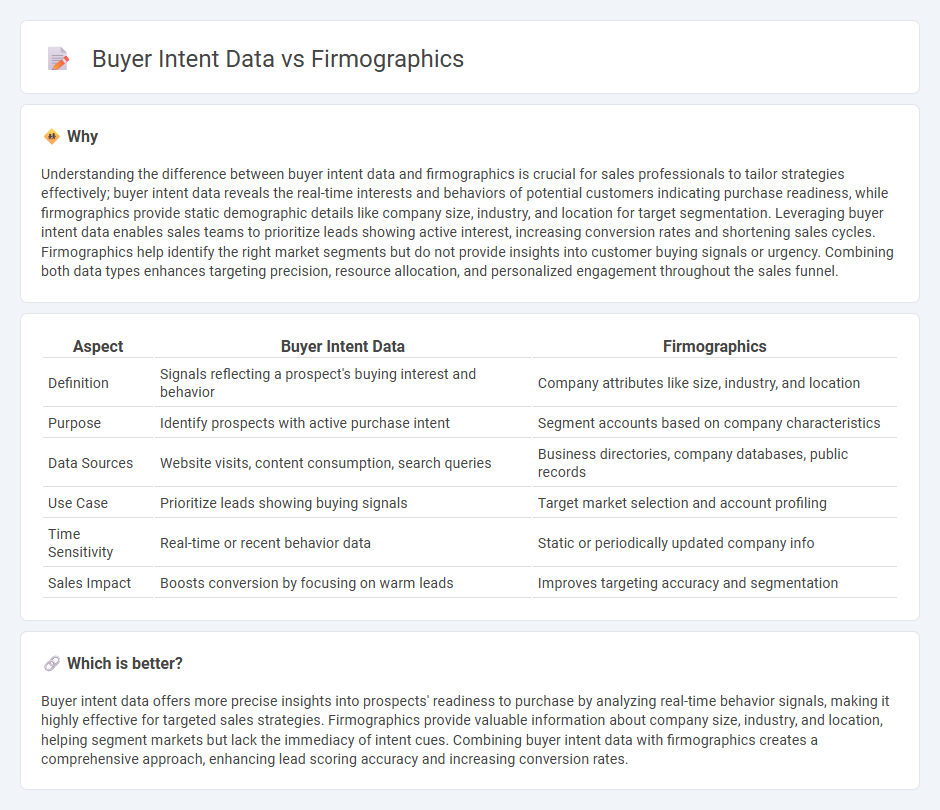
Buyer intent data reveals real-time insights into potential customers' behaviors and interests, enabling sales teams to prioritize leads with high purchase intent. Firmographics provide structured information about companies, such as industry, size, and location, helping to segment and target market efficiently. Explore how combining buyer intent data and firmographics can enhance sales strategies and drive revenue growth.
Why it is important
Understanding the difference between buyer intent data and firmographics is crucial for sales professionals to tailor strategies effectively; buyer intent data reveals the real-time interests and behaviors of potential customers indicating purchase readiness, while firmographics provide static demographic details like company size, industry, and location for target segmentation. Leveraging buyer intent data enables sales teams to prioritize leads showing active interest, increasing conversion rates and shortening sales cycles. Firmographics help identify the right market segments but do not provide insights into customer buying signals or urgency. Combining both data types enhances targeting precision, resource allocation, and personalized engagement throughout the sales funnel.
Comparison Table
| Aspect | Buyer Intent Data | Firmographics |
|---|---|---|
| Definition | Signals reflecting a prospect's buying interest and behavior | Company attributes like size, industry, and location |
| Purpose | Identify prospects with active purchase intent | Segment accounts based on company characteristics |
| Data Sources | Website visits, content consumption, search queries | Business directories, company databases, public records |
| Use Case | Prioritize leads showing buying signals | Target market selection and account profiling |
| Time Sensitivity | Real-time or recent behavior data | Static or periodically updated company info |
| Sales Impact | Boosts conversion by focusing on warm leads | Improves targeting accuracy and segmentation |
Which is better?
Buyer intent data offers more precise insights into prospects' readiness to purchase by analyzing real-time behavior signals, making it highly effective for targeted sales strategies. Firmographics provide valuable information about company size, industry, and location, helping segment markets but lack the immediacy of intent cues. Combining buyer intent data with firmographics creates a comprehensive approach, enhancing lead scoring accuracy and increasing conversion rates.
Connection
Buyer intent data reveals the behavioral signals and online activities indicating a prospect's readiness to purchase, while firmographics provide essential details about the company's size, industry, location, and revenue. Integrating buyer intent data with firmographic insights enables sales teams to prioritize high-potential accounts by aligning purchasing intent with relevant organizational characteristics. This connection enhances targeted outreach, improves lead scoring accuracy, and increases conversion rates by focusing efforts on the most strategic prospects.
Key Terms
Firmographics:
Firmographics refer to the categorization of companies based on attributes such as industry, company size, location, and annual revenue, providing essential insights for B2B marketing and sales strategies. This data helps businesses tailor their outreach to target organizations that match their ideal customer profile, enhancing lead qualification and segmentation accuracy. Explore how firmographics can refine your market analysis and improve customer acquisition efforts.
Industry
Firmographics categorize companies based on industry, revenue, size, and location to segment markets effectively, while buyer intent data captures real-time signals indicating a company's interest or readiness to purchase specific products or services. Industry-focused firmographics provide a foundational understanding for targeting, but buyer intent data reveals deeper insights into when businesses within those industries are actively researching solutions, enabling timely engagement. Discover how combining firmographics with buyer intent data can enhance your marketing strategy and drive higher conversion rates.
Company Size
Firmographics categorize companies by attributes such as company size, industry, and location to help segment markets and tailor B2B marketing strategies effectively. Buyer intent data captures online behavior signals that indicate a company's interest in specific products or services, enabling more precise targeting based on real-time engagement. Explore how integrating firmographics with buyer intent data can enhance your sales and marketing efforts.
Source and External Links
Firmographics - Wikipedia - Firmographics are sets of characteristics used to segment organizations, analogous to demographics for individuals, and commonly include industry, company size, and location.
What is Firmographic Data? - Demandbase - Firmographic data describes business attributes such as industry, size, revenue, location, and employee count, and is essential for targeted B2B marketing and segmentation.
The Ultimate Guide To Firmographic Segmentation | SurveyMonkey - Firmographic segmentation variables encompass industry classification, legal status, years in business, and number of employees, helping marketers refine their targeting strategies.
 dowidth.com
dowidth.com